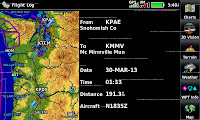The documentary movie "Air Racers 3D" was released about a year ago. It was just after the crash at the Reno races in which my friend's brother was killed. They were at the races together with their parents when the plane went into the ground just behind their box seats. The debris passed over my friend, his wife, and father who were all seated, but his brother was standing and the debris passed through him. It was a traumatic and terrible event.
The movie played briefly at the IMAX theater near my house, but I was unable to carve out time in my schedule to see it. As a gift to myself I decided to make the trek to Evergreen Air and Space Museum to see the movie and take in the museum.
I filed an IFR flight plan for the trip down, we got off the ground late, and then got some ridiculous routing before getting on course to the west of Sea-Tac's class "Bravo" airspace, and then we were vectored around further for traffic. The weather was perfect, and I really didn't need to be IFR, but I wanted the practice in the system. We ended up arriving with minimal time to get across the street to the theater.
The museum was created by the Evergreen International Aviation Company. Most recently this is the company that coordinated the 747 LCF, and the 747 fire suppressant tankers. Early in their history they were recognized as Air America.
When I was last there, it was a single large building housing the HK-1 (nee H-4) Hercules and a chaos of other planes squeezed in where there was space. The campus has since been expanded to four buildings . Most prominent of the new buildings is the one furthest to the west with a 747 mounted on top with water slides protruding from the sides. Next in line is the original building that still houses the spruce goose, then the IMAX theater, and finally on the east end is the space building.
The original building is now much better organized, containing primarily propeller driven planes with piston engines. Notable displays include a several of the more famous WW II planes including the P-38, P-51, F-4U, and some German FW-190 and ME-262. There is even a fair amount of empty space.

|
| SR-71 and J-58 engine |

|
| Rocket Engine and Control Ring |
We arrived at the museum just in time for the movie to begin. The movie is short, only about 40ish minutes. I may be aviation biased, but of all the 3-D movies I have seen, the is the first that really works to add to the story-telling and immersing the viewer into the story. We ended up flying for three and a half hours to see a 40 minute movie, but the flight, movie, and museum were quite enjoyable. Any of the activities alone would have made for a good day. Sandra, my wife, also watched the feature on Lewis and Clark, and came back disappointed she had not insisted our kids go with her.
On the way home we skirted east along the south side of Portland's class "Charlie" airspace until we were above it and on flight-following before turning north over the top of the airport and headed for the east side of Seattle over the foothills of the Cascade range,
|
|
| Mt St Helens |
|
|
| Mt Rainier |
My oldest son had hiked to the top of Mt Si earlier this week during his spring break.
|
|
| Mt Si |
We were home in time for a nice meal at a local restaurant, and over dinner everyone agreed it had been a great day.


